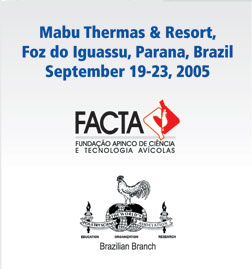Contributed Papers: Oral Presentations
Cell Biology |
Plastid Replication
in Apicomplexan Parasites
1Shipra Vaishnava, 2Marc-Jan Gubbels, 3Raj Gaji,
4John Murray, 3Daniel Howe and 1,2Boris Striepen
1Department of Cellular Biology and
2Center for Tropical and Emerging Global Diseases,
University of Georgia, Athens, GA 30602, USA;
3Gluck Equine Research Center, Department of
Veterinary Science, University of Kentucky, Lexington
40546, USA;
4Department of Cell and Development Biology, University
of Pennsylvania, PA 19104, USA
Apicomplexan parasites harbor a secondary plastid
which is essential for development and pathogenesis.
Several plastid localized metabolic and housekeeping
enzymes have emerged as promising drug targets in
Toxoplasma and Plasmodium. We are studying the replication
and segregation of this important organelle and its
genome. Our genomic analysis reveals that Apicomplexa
have lost all elements of the conserved chloroplast/cyanobacterial
division machinery including FtsZ, and several Min
and Arc genes. We hypothesize that in contrast to
plants and algae the plastid in Apicomplexa, is segregated
using a genuinely eukaryotic mechanism, association
with the centrosomes of the mitotic spindle. We have
tested this hypothesis in T. gondii and S. neurona,
which we show to have highly organized linear plastids.
We show tight association of the plastid and spindle
poles throughout the cell cycle. Using pharmacological
experiments ablating the parasite’s microtubules
we show that spindles are essential for plastid organization.
Using several molecular markers we further show that
fission of the single plastid occurs late and concurs
with daughter cell formation. Using transgenic S.
neurona and in-vivo microscopy and laser bleaching
experiments we have further tested our model of organellar
fission in living cells. FISH analysis employing probes
specific for the 35 kb plastid genome suggest that
the organellar genome might be positioned and segregated
by centrosomes as well. In contrast to the fission
machinery the genome replication apparatus of apicomplexans
seems of prokaryotic origin. To develop robust molecular
markers for the genome’s position we have cloned
the putative T. gondii plastid histone-like HU, PolA
and helicase genes. We show that the T. gondii HU
protein complements the respective mutant in E. coli.
Antibodies raised against the recombinant protein
show that HU is indeed localized to the plastid and
associates with the plastid genome. Overexpression
of a HU-YFP fusion protein in T. gondii has a pronounced
dominant negative effect on organellar genome replication
yielding plastids devoid of a genome.
